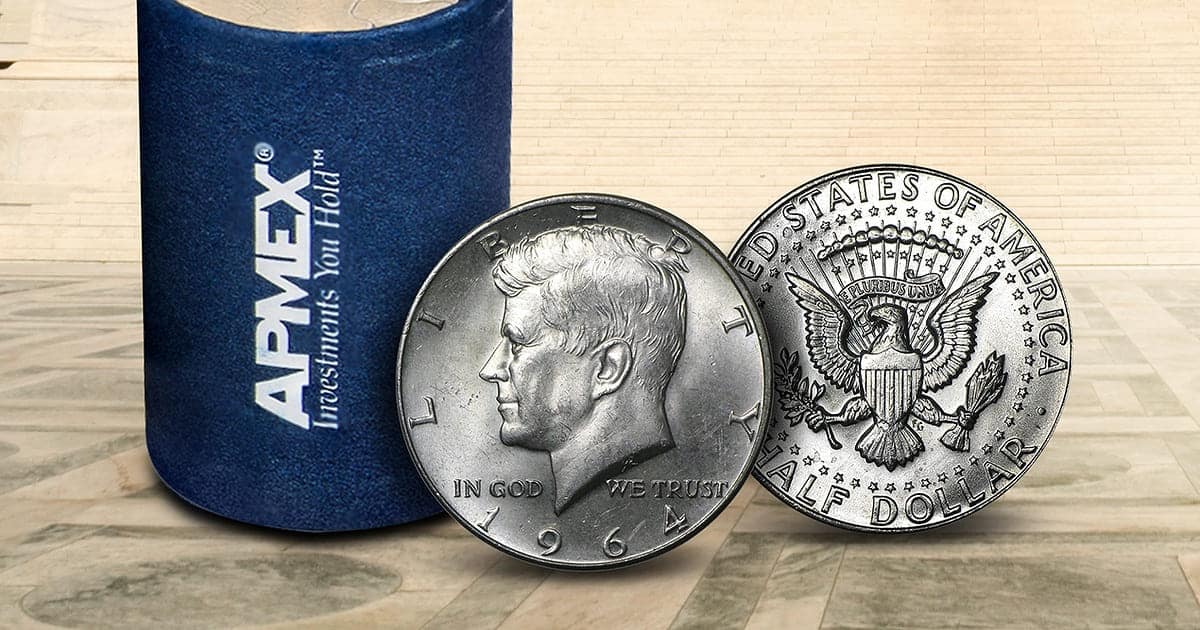
The History and Value of the Kennedy Half Dollar
The Kennedy half dollar is an iconic American coin that can trace its genesis back to mere hours after the famous president’s assassination in November of 1963. These coins were struck in massive numbers, but few people have ever seen them in circulation. The Kennedy’s place in U.S. numismatic history is unique due to its timing in relation to the U.S. stopping business strikes of Silver coins. It’s worth an examination to see what these exciting coins are worth.
The Kennedy Half Dollar’s History
The half dollar is a nearly obsolete denomination now, but it was one of the foundational coins established in the Coinage Act of 1792. One of the most famous half dollars was struck in the aftermath of the Kennedy assassination. The Kennedy half dollar was approved for circulation within days of the assassination as a memorial to the dead president, and it saw massive mintages for the first few years. Mintages trailed off as the denomination got less popular and everyone who wanted a coin by which to remember President Kennedy had already saved one, and by 2002 the coin was no longer struck for circulation.
In terms of numbers, though, the Kennedy had become by far the most popular half dollar ever in American history by that point. Over 2.5 billion were struck, and though the Silver boom of 1979 through 1980 saw some destroyed and melted, the overwhelming majority of them still survive today.
The Kennedy was struck during the transition between Silver coinage (up to 1964) and modern clad (1965 and beyond) circulating coins. The 1964-dated issue was struck of 90% Silver and 10% Copper, the same alloy previous Silver coins had been struck from. The coins issued between 1965 and 1970 were made from 40% Silver and 60% Copper. This composition continued until 1971, when they were replaced by a cupro-nickel alloy over a Copper core. The 1971-D and 1977-D have a few that were struck from Silver in error, but they are very rare.
The design had Kennedy’s face on the obverse with the Presidential Coat of Arms on the reverse. In 1975 and 1976, in order to honor our nation’s bicentennial celebrations, a special reverse showing Independence Hall was used and the dating was changed to “1776—1976”. The previous reverse then resumed as did the use of the current date and this reverse has been used to the present day.
Collectible Value of Kennedy Half Dollars
Many Silver coins struck before 1964 are not just collectible for their numismatic value, but for their precious metal content. The 1964 Kennedy half is the only 90% Silver Kennedy and as such it always retains its intrinsic metal value as well as any collectible value should the coin have been saved in a high state of preservation. The pre-1971 issues (1965 to 1970) are valued for their 40% silver content, but they are not as popular as the 90% Silver issue.
Despite the lower Silver content, these coins were hoarded in huge numbers. The Treasury had a large stockpile of Silver. Still, the vast initial mintages were rapidly depleting it even with subsidiary coins like the dime and quarter now being struck in cupro-nickel. Almost 430 million Kennedy half dollars were struck with a 1964 date, which outpaced the entire Franklin series mintage in a single year.
Silver stockpiles continued to deplete, and eventually, the switch to clad coinage stopped the hoarding of regular circulating half dollars. At that point, the only Silver coins available were Silver proofs, which have been struck from that point to the present and for which the U.S. Mint charges a premium for the Silver content and their special handling and packaging.
One of the most common uses of these half dollars was in casinos in slot machines, which changed as casinos began switching their slot machines to more electronic versions that did not use coins whatsoever. Other than the casinos, the Kennedy half was rarely seen in commerce, and most people have probably never come across one in the wild.
Because of this lack of circulation, Kennedy half dollars in good condition are very common. The Red Book, the most common coin collecting resource, doesn’t even list a grade below MS-60 in its pricing chart for the Kennedy half. Premiums on these are very low, and type sets are easy to assemble. The clad examples are usually very inexpensive, only costing a few dollars. The 1964 is a little more expensive, but still very reasonable.
There are a few expensive examples. The lowest mintage is the 1998 matte finish Kennedy half, with a little over 60,000. The Accented Hair variety is a little rarer as well, and some of the 1966 half dollars have missing initials. Some 1964 Special Mint Set half dollars can be found, but they are extremely rare. Some Kennedy half dollars saved in an unusually high state of preservation may also command significant premiums. Most of the Kennedy half dollar coins are not rare, expensive or hard to find, though.
APMEX keeps a large variety of coins on hand, and if you’re hunting for a specific coin, we can help. You can buy or sell your rare and collectible coins with us as your partner. Contact us today if you want to sell your coins.
If you are looking to expand your collection, shop our assortment of Kennedy Half Dollars.





